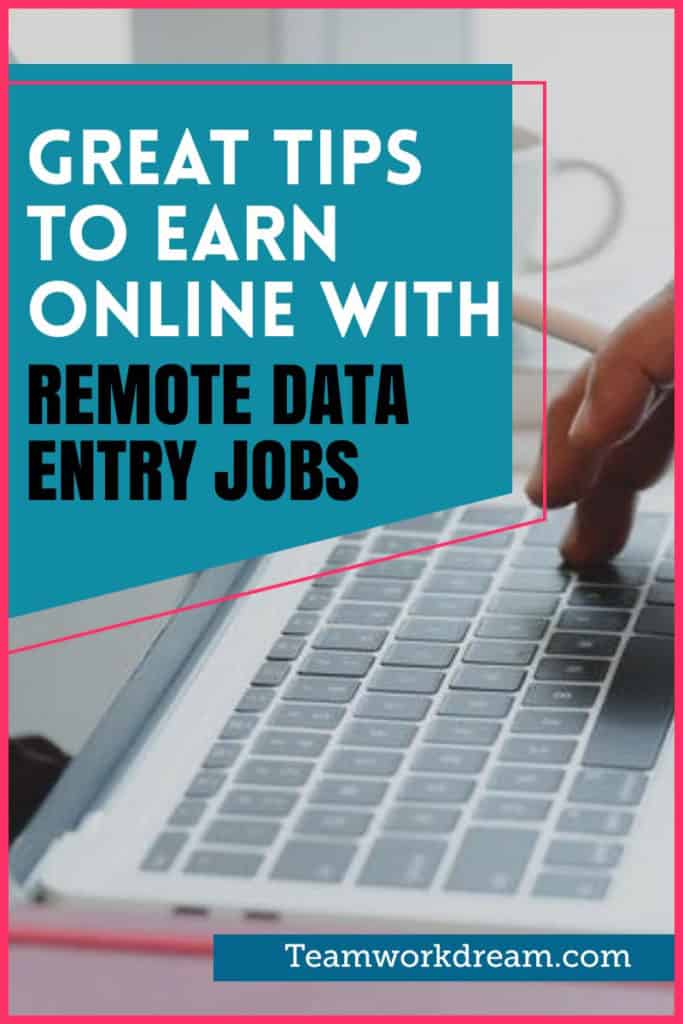What is Remote Data Entry and Why is it in Demand?
Remote data entry, also known as telecommuting or working from home, has become an increasingly popular career choice in recent years. With the advancement of technology and the rise of the digital age, many companies are now open to hiring freelancers and remote workers to perform various tasks, including data entry. Freelance remote data entry jobs involve entering information into a computer database or spreadsheet for clients, often from the comfort of one’s own home.
The demand for remote data entry services is growing rapidly, driven by the need for businesses to outsource tasks and reduce costs. Many companies, especially those in the healthcare, finance, and e-commerce industries, require large amounts of data to be entered into their systems, making remote data entry a crucial part of their operations. As a result, freelance remote data entry jobs have become a viable career option for those looking for flexible and autonomous work arrangements.
One of the primary benefits of remote data entry work is its flexibility. Freelancers can choose their own schedules, work at their own pace, and select projects that fit their skills and interests. This flexibility is particularly appealing to those who value work-life balance, have caregiving responsibilities, or live in areas with limited job opportunities. Additionally, remote data entry work provides opportunities for career advancement, as freelancers can develop new skills, build their portfolios, and expand their client base.
According to industry reports, the demand for remote data entry services is expected to continue growing in the coming years, driven by the increasing need for digital transformation and data-driven decision-making. As a result, freelance remote data entry jobs are likely to remain a popular career choice for those looking for flexible, autonomous, and fulfilling work arrangements.
How to Get Started with Freelance Remote Data Entry Jobs
Breaking into the world of freelance remote data entry jobs requires a strategic approach. To increase your chances of success, follow these step-by-step guidelines to get started:
Step 1: Create a Professional Profile
Develop a professional profile that showcases your skills, experience, and education. Highlight your data entry skills, typing speed, and accuracy. Include any relevant certifications or training programs you’ve completed. Use platforms like LinkedIn or Upwork to create a profile that will help you stand out to potential clients.
Step 2: Build a Portfolio
Build a portfolio that demonstrates your data entry skills and experience. Include samples of your work, such as spreadsheets or databases you’ve created. Share your portfolio on your professional profile or website to showcase your abilities to potential clients.
Step 3: Find Job Opportunities
Search for freelance remote data entry job opportunities on platforms like Upwork, Fiverr, or Freelancer. Use keywords like “remote data entry jobs” or “freelance data entry work” to find relevant job postings. You can also search for job openings on company websites or job boards.
Step 4: Prepare for Job Applications
Prepare for job applications by updating your resume and cover letter. Tailor your application materials to the specific job you’re applying for, highlighting your relevant skills and experience. Practice your interview skills to increase your chances of landing a job.
Step 5: Stay Organized and Focused
Stay organized and focused by creating a schedule and setting goals for yourself. Prioritize your tasks and minimize distractions to ensure you meet deadlines and deliver high-quality work. Continuously evaluate and improve your skills to stay competitive in the freelance remote data entry job market.
By following these steps, you’ll be well on your way to launching a successful career in freelance remote data entry jobs. Remember to stay flexible, adapt to new technologies and trends, and continuously develop your skills to achieve long-term success.
Top Platforms for Finding Freelance Remote Data Entry Work
When it comes to finding freelance remote data entry jobs, there are several platforms that can help you get started. Here are some of the top platforms to consider:
Upwork: Upwork is one of the largest freelance marketplaces, with a wide range of remote data entry jobs available. Create a professional profile, showcase your skills, and bid on jobs that match your expertise.
Fiverr: Fiverr is a unique platform that allows you to offer your services starting at $5 per project. Create a gig for your data entry services, and attract clients looking for affordable and efficient solutions.
Freelancer: Freelancer is another popular platform that connects freelancers with clients looking for remote data entry work. Create a profile, showcase your portfolio, and bid on jobs that match your skills.
Amazon’s Virtual Jobs: Amazon’s Virtual Jobs platform offers a range of remote data entry jobs, including opportunities to work as a virtual customer service representative or data entry clerk.
Remote.co: Remote.co is a platform that specializes in remote job listings, including freelance remote data entry jobs. Search for job openings, and apply to positions that match your skills and experience.
To increase your visibility and attract clients on these platforms, make sure to:
Create a professional profile that showcases your skills and experience
Develop a strong portfolio that demonstrates your data entry skills
Optimize your profile and portfolio with relevant keywords
Engage with potential clients by responding to messages and comments
Deliver high-quality work to build your reputation and attract repeat business
By leveraging these platforms and following these tips, you can increase your chances of finding freelance remote data entry jobs and building a successful career in this field.
Essential Skills and Tools for Remote Data Entry Success
To succeed in freelance remote data entry jobs, you’ll need to possess a combination of technical, business, and soft skills. Here are some of the essential skills and tools required for remote data entry success:
Data Entry Software: Familiarity with data entry software such as Microsoft Excel, Google Sheets, or specialized data entry tools like Zoho Inventory or TradeGecko is crucial for remote data entry work.
Typing Speed and Accuracy: A high typing speed and accuracy are essential for remote data entry work. Aim for a minimum of 60 words per minute (wpm) with high accuracy.
Attention to Detail: Remote data entry requires attention to detail to ensure accuracy and quality of work. Develop a habit of double-checking your work to minimize errors.
Organizational Skills: Remote data entry freelancers need to be organized and able to manage multiple projects simultaneously. Use tools like Trello or Asana to stay organized and focused.
Communication Skills: Effective communication is critical for remote data entry freelancers. Develop strong written and verbal communication skills to interact with clients and colleagues.
Time Management: Remote data entry freelancers need to be able to manage their time effectively to meet deadlines and deliver quality work. Use tools like RescueTime or Harvest to track your time and stay focused.
Technical Skills: Familiarity with technical tools like cloud storage (e.g., Google Drive, Dropbox), password management (e.g., LastPass), and antivirus software (e.g., Norton) is essential for remote data entry work.
Continuous Learning: The remote data entry landscape is constantly evolving, with new tools and technologies emerging regularly. Stay up-to-date with the latest developments and best practices to remain competitive.
By possessing these essential skills and tools, you’ll be well-equipped to succeed in freelance remote data entry jobs and build a sustainable career in this field.
Managing Your Time and Productivity as a Remote Data Entry Freelancer
As a remote data entry freelancer, managing your time and productivity is crucial to delivering high-quality work and meeting deadlines. Here are some tips and strategies to help you stay focused and productive:
Set a Schedule: Create a schedule that works for you and stick to it. Set specific work hours and breaks to maintain a healthy work-life balance.
Prioritize Tasks: Prioritize your tasks based on their urgency and importance. Focus on completing the most critical tasks first, and then move on to less pressing ones.
Minimize Distractions: Minimize distractions by creating a dedicated workspace that is quiet, comfortable, and free from interruptions. Use tools like website blockers or apps that help you stay focused.
Use Time-Tracking Tools: Use time-tracking tools like Toggl, Harvest, or RescueTime to track your time and stay organized. These tools can help you identify areas where you can improve your productivity.
Take Breaks: Take regular breaks to recharge and avoid burnout. Use your breaks to do something enjoyable or relaxing, like taking a walk or meditating.
Stay Organized: Stay organized by using tools like to-do lists, calendars, or project management software. These tools can help you keep track of your tasks, deadlines, and progress.
Learn to Say No: Learn to say no to non-essential tasks or projects that can derail your focus. Prioritize your existing commitments and avoid taking on too much at once.
Continuously Evaluate and Improve: Continuously evaluate and improve your time management and productivity strategies. Identify areas where you can improve and implement changes to optimize your workflow.
By implementing these strategies, you can effectively manage your time and productivity as a remote data entry freelancer, delivering high-quality work and building a successful career in this field.
Common Challenges and Solutions for Remote Data Entry Freelancers
As a remote data entry freelancer, you may face several challenges that can impact your productivity and success. Here are some common challenges and solutions to help you overcome them:
Isolation: One of the biggest challenges of remote work is isolation. To combat this, join online communities or forums for remote data entry freelancers, participate in online events or webinars, and schedule regular video calls with clients or colleagues.
Technical Issues: Technical issues can be frustrating and impact your productivity. To minimize technical issues, invest in a reliable computer and internet connection, use cloud-based data entry software, and have a backup plan in place in case of technical failures.
Payment Concerns: Payment concerns can be a major challenge for remote data entry freelancers. To minimize payment concerns, use secure payment platforms like PayPal or Stripe, set clear payment terms with clients, and consider using a payment protection service.
Time Zone Differences: Time zone differences can make it challenging to communicate with clients or colleagues. To overcome this, use time zone-friendly communication tools like Zoom or Skype, and schedule meetings or calls during overlapping time zones.
Distractions: Distractions can be a major challenge for remote data entry freelancers. To minimize distractions, create a dedicated workspace, use website blockers or apps that help you stay focused, and schedule regular breaks to recharge.
Lack of Structure: Lack of structure can make it challenging to stay organized and productive. To overcome this, create a schedule and stick to it, use project management tools like Trello or Asana, and set clear goals and deadlines for yourself.
By being aware of these common challenges and having solutions in place, you can overcome them and achieve success as a remote data entry freelancer.
Building a Sustainable Career in Remote Data Entry
To build a sustainable career in remote data entry, it’s essential to focus on continuous learning, professional development, and expanding services to attract higher-paying clients. As a freelancer in this field, staying up-to-date with the latest industry trends, software, and technologies is crucial for success. This can be achieved by attending webinars, workshops, and online courses that enhance skills and knowledge in data entry, data analysis, and data management.
Investing in professional development can also lead to increased earning potential and access to more lucrative freelance remote data entry jobs. Consider obtaining certifications in data entry, data analysis, or related fields to demonstrate expertise and commitment to potential clients. Additionally, building a strong online presence through a professional website or portfolio can help showcase skills and attract high-paying clients.
Expanding services is another key strategy for building a sustainable career in remote data entry. Consider offering additional services such as data analysis, data visualization, or virtual assistance to attract clients who require more comprehensive support. This can also help to differentiate yourself from other freelancers and increase earning potential.
Networking is also vital for building a sustainable career in remote data entry. Join online communities, forums, and social media groups to connect with other freelancers, potential clients, and industry experts. This can lead to valuable connections, job opportunities, and access to industry insights and best practices.
Finally, it’s essential to stay organized and focused on long-term goals. Set clear objectives, prioritize tasks, and manage time effectively to ensure a sustainable and fulfilling career in remote data entry. By following these strategies, freelancers can build a successful and sustainable career in remote data entry and enjoy the benefits of flexibility, autonomy, and unlimited earning potential.
Conclusion: Unlocking Your Potential in Remote Data Entry
In conclusion, freelance remote data entry jobs offer a flexible and fulfilling career path for those looking to work independently and have control over their schedules. By understanding the concept of remote data entry, getting started with freelance work, and building a sustainable career, individuals can unlock their potential and achieve success in this field.
Throughout this guide, we have provided valuable insights and practical tips on how to navigate the world of remote data entry. From creating a professional profile and building a portfolio to managing time and productivity, we have covered the essential skills and tools required for success.
As the demand for remote data entry services continues to grow, it’s essential to stay ahead of the curve and continuously develop skills and knowledge. By expanding services, networking, and staying organized, freelancers can attract higher-paying clients and build a sustainable career in remote data entry.
Whether you’re looking to supplement your income, transition to a new career, or simply enjoy the flexibility of remote work, freelance remote data entry jobs offer a world of opportunities. Take the first step today and unlock your potential in remote data entry.
Remember, building a successful career in remote data entry requires dedication, hard work, and a willingness to continuously learn and adapt. By following the guidance provided in this article, you can set yourself up for success and enjoy the many benefits that come with working in this field.





